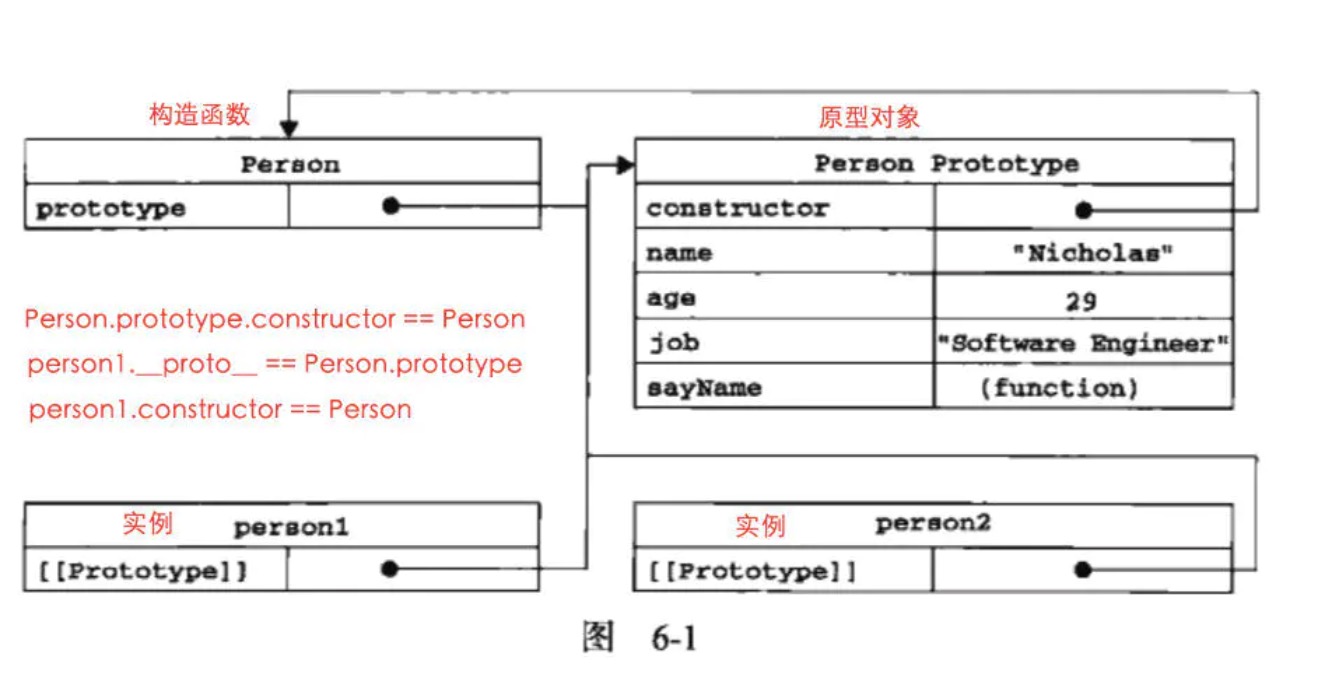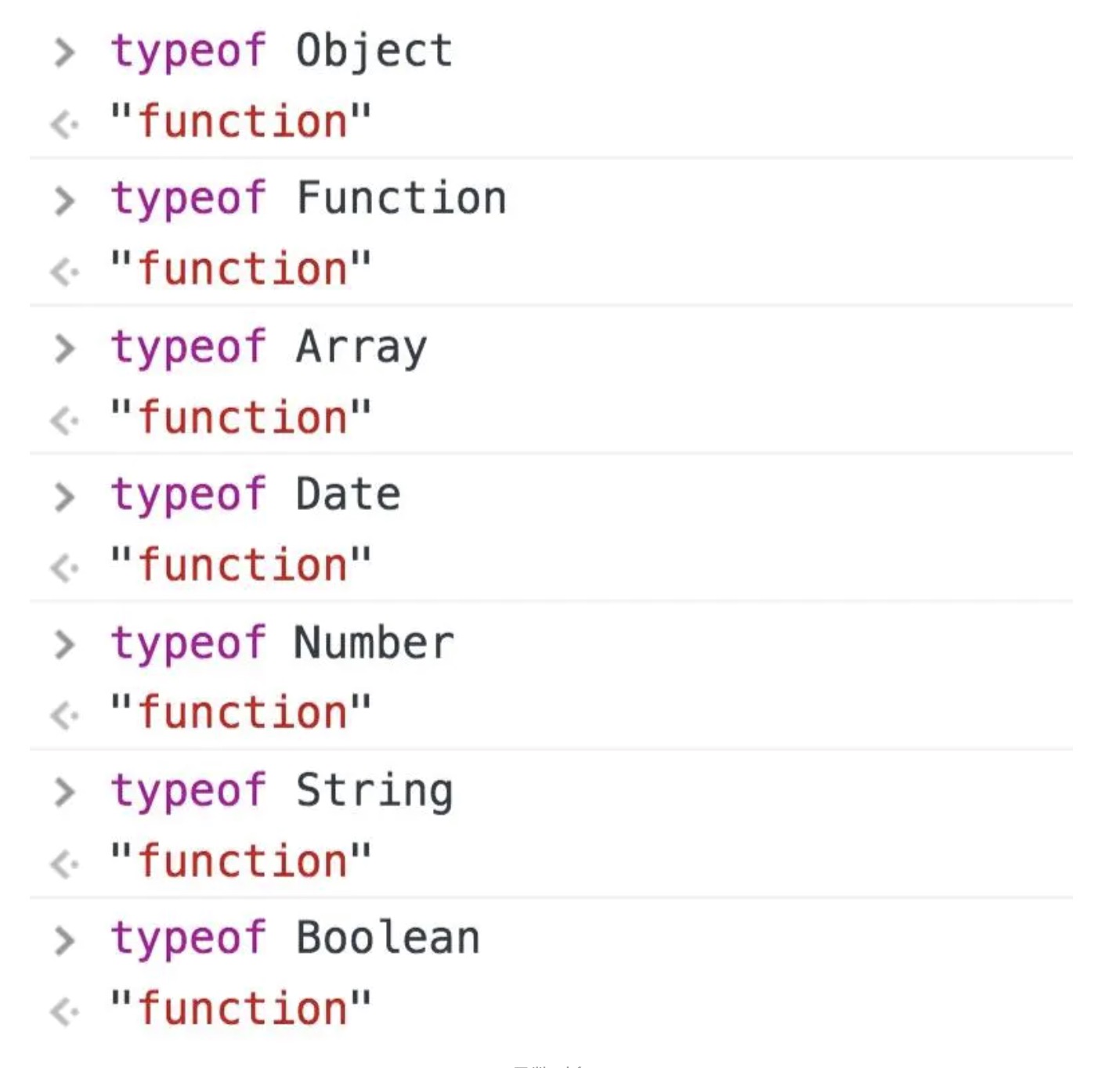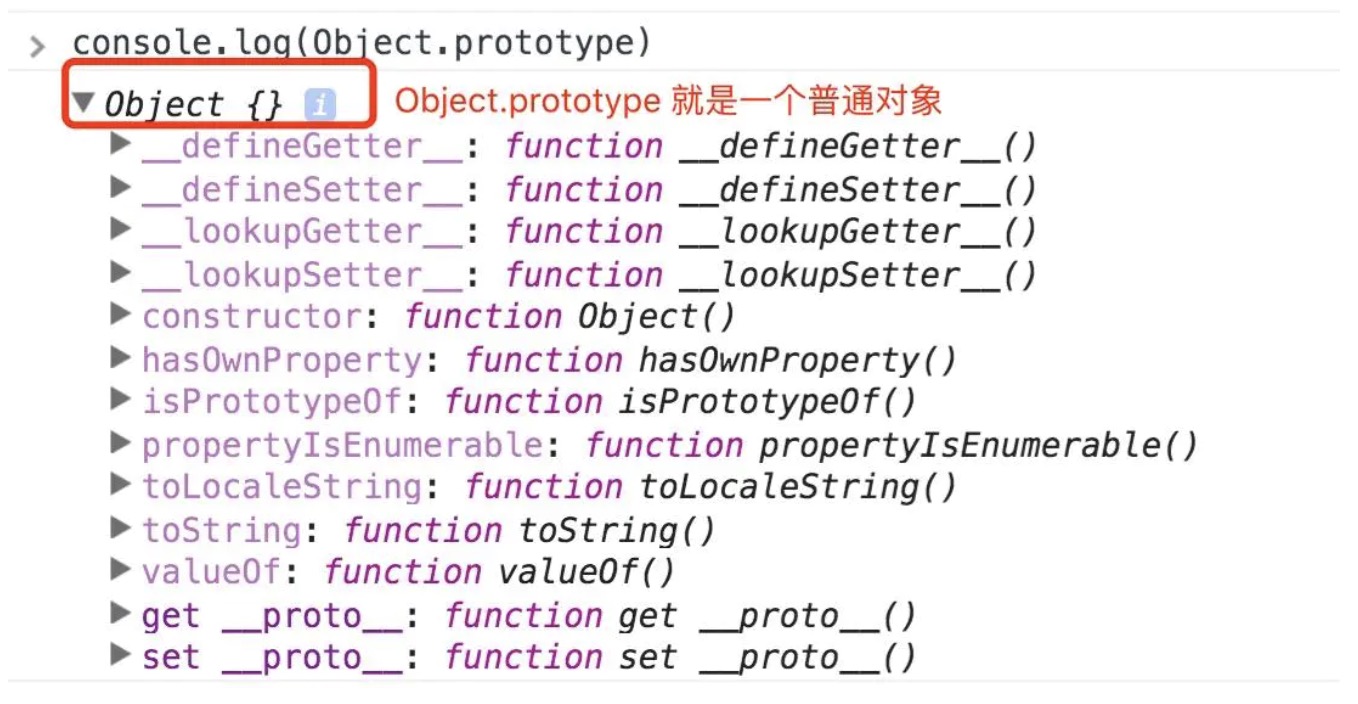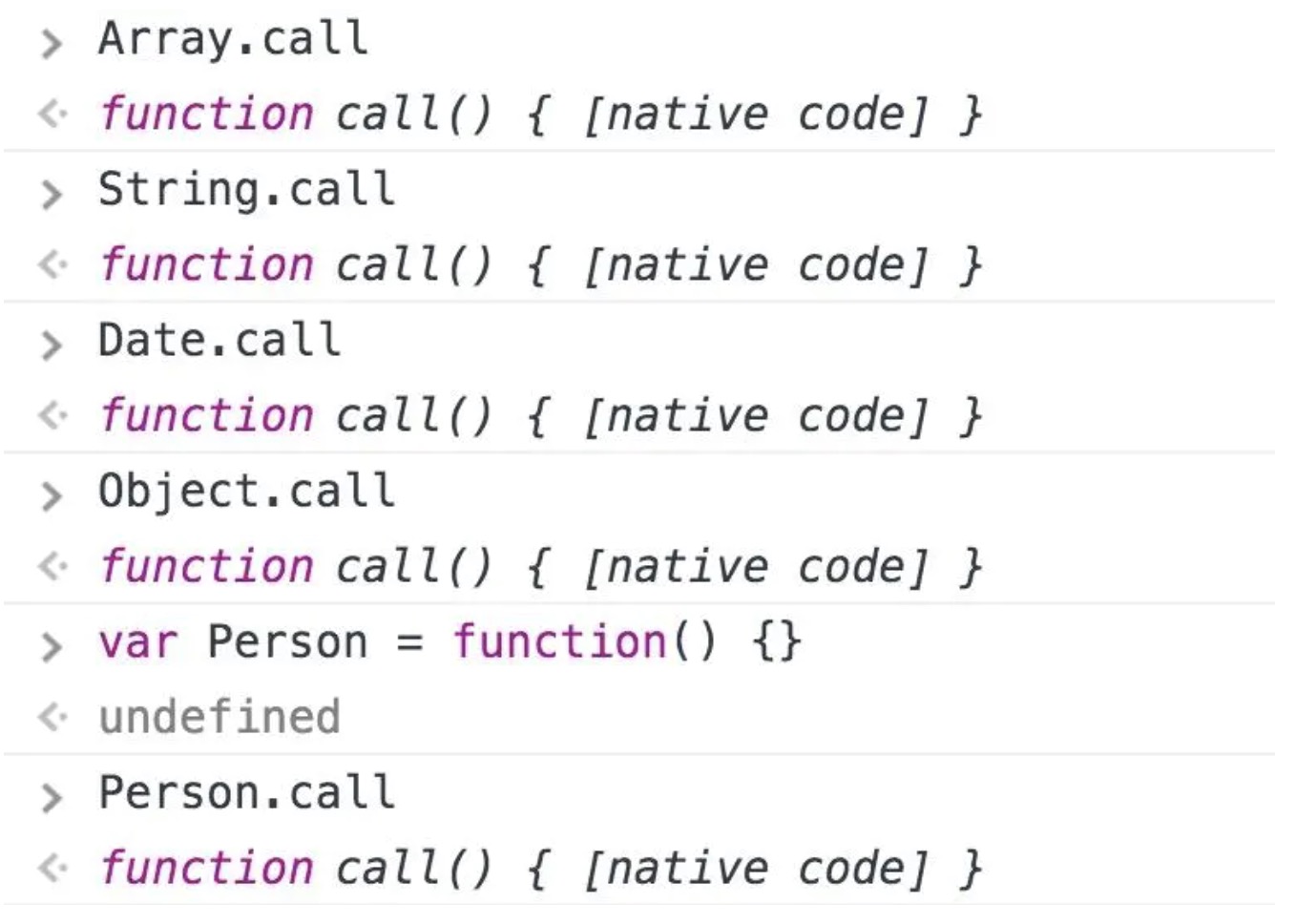普通对象与函数对象
JavaScript 中,万物皆对象!但对象也是有区别的。分为普通对象和函数对象,Object 、Function 是 JS 自带的函数对象。
var o1 = {}
var o2 = new Object()
var o3 = new f1()
function f1() {}
var f2 = function() {}
var f3 = new Function('str', 'console.log(str)')
console.log(typeof Object) //function
console.log(typeof Function) //function
console.log(typeof f1) //function
console.log(typeof f2) //function
console.log(typeof f3) //function
console.log(typeof o1) //object
console.log(typeof o2) //object
console.log(typeof o3) //object
在上面的例子中 o1 o2 o3 为普通对象,f1 f2 f3 为函数对象。怎么区分,其实很简单,凡是通过 new Function() 创建的对象都是函数对象,其他的都是普通对象。f1,f2,归根结底都是通过 new Function()的方式进行创建的。Function Object 也都是通过 New Function()创建的。
构造函数
我们先复习一下构造函数的知识:
function Person(name, age, job) {
this.name = name
this.age = age
this.job = job
this.sayName = function() {
alert(this.name)
}
}
var person1 = new Person('Zaxlct', 28, 'Software Engineer')
var person2 = new Person('Mick', 23, 'Doctor')
上面的例子中 person1 和 person2 都是 Person 的实例。这两个实例都有一个 constructor (构造函数)属性,该属性(是一个指针)指向 Person。 即:
console.log(person1.constructor == Person) //true
console.log(person2.constructor == Person) //true
我们要记住两个概念(构造函数,实例):person1 和 person2 都是 构造函数 Person 的实例
一个公式:实例的构造函数属性(constructor)指向构造函数
原型对象
在 JavaScript 中,每当定义一个对象(函数也是对象)时候,对象中都会包含一些预定义的属性。其中每个函数对象都有一个 prototype 属性,这个属性指向函数的原型对象。
function Person() {}
Person.prototype.name = 'Zaxlct'
Person.prototype.age = 28
Person.prototype.job = 'Software Engineer'
Person.prototype.sayName = function() {
alert(this.name)
}
var person1 = new Person()
person1.sayName() // 'Zaxlct'
var person2 = new Person()
person2.sayName() // 'Zaxlct'
console.log(person1.sayName == person2.sayName) //true
我们得到了本文第一个「定律」:
每个对象都有 __proto__ 属性,但只有函数对象才有 prototype 属性
那什么是原型对象呢?
我们把上面的例子改一改你就会明白了:
Person.prototype = {
name: 'Zaxlct',
age: 28,
job: 'Software Engineer',
sayName: function() {
alert(this.name)
},
}
原型对象,顾名思义,它就是一个普通对象(废话 = =!)。从现在开始你要牢牢记住原型对象就是 Person.prototype ,如果你还是害怕它,那就把它想想成一个字母 A: var A = Person.prototype
在上面我们给 A 添加了 四个属性:name、age、job、sayName。其实它还有一个默认的属性:constructor
在默认情况下,所有的原型对象都会自动获得一个
constructor(构造函数)属性,这个属性(是一个指针)指向prototype属性所在的函数(Person)
上面这句话有点拗口,我们「翻译」一下:A 有一个默认的 constructor 属性,这个属性是一个指针,指向 Person。即:Person.prototype.constructor == Person
在上面第二小节《构造函数》里,我们知道实例的构造函数属性(constructor)指向构造函数 :person1.constructor == Person
这两个「公式」好像有点联系:
person1.constructor == Person
Person.prototype.constructor == Person
person1 为什么有 constructor 属性?那是因为 person1 是 Person 的实例。
那 Person.prototype 为什么有 constructor 属性??
同理, Person.prototype (你把它想象成 A) 也是 Person 的实例。也就是在 Person 创建的时候,创建了一个它的实例对象并赋值给它的 prototype,基本过程如下:
var A = new Person()
Person.prototype = A
// 注:上面两行代码只是帮助理解,并不能正常运行
结论:原型对象(Person.prototype)是 构造函数(Person)的一个实例。
原型对象其实就是普通对象(但 Function.prototype 除外,它是函数对象,但它很特殊,他没有 prototype 属性(前面说道函数对象都有 prototype 属性)).看下面的例子:
function Person() {}
console.log(Person.prototype) //Person{}
console.log(typeof Person.prototype) //Object
console.log(typeof Function.prototype) // Function,这个特殊
console.log(typeof Object.prototype) // Object
console.log(typeof Function.prototype.prototype) //undefined
Function.prototype 为什么是函数对象呢?
var A = new Function()
Function.prototype = A
注意:上文提到凡是通过 new Function() 产生的对象都是函数对象。因为 A 是函数对象,所以 Function.prototype 是函数对象。
那原型对象是用来做什么的呢?主要作用是用于 继承。举个例子:
var Person = function(name) {
this.name = name // tip: 当函数执行时这个 this 指的是谁?
}
Person.prototype.getName = function() {
return this.name // tip: 当函数执行时这个 this 指的是谁?
}
var person1 = new person('Mick')
person1.getName() //Mick
从这个例子可以看出,通过给 Person.prototype 设置了一个函数对象的属性,那有 Person 的实例(person1)出来的普通对象就继承了这个属性。具体是怎么实现的继承,就要讲到下面的原型链了。
小问题,上面两个 this 都指向谁?
var person1 = new person('Mick')
person1.name = 'Mick' // 此时 person1 已经有 name 这个属性了
person1.getName() //Mick
故, 两次 this 在函数执行时都指向 person1。
proto
JS 在创建对象(不论是普通对象还是函数对象)的时候,都有一个叫做proto 的内置属性,用于指向创建它的构造函数的原型对象。
对象 person1 有一个 proto属性,创建它的构造函数是 Person,构造函数的原型对象是 Person.prototype ,所以:person1.**proto** == Person.prototype
请看下图:

根据上面这个连接图,我们能得到:
Person.prototype.constructor == Person
person1.__proto__ == Person.prototype
person1.constructor == Person
不过,要明确的真正重要的一点就是,这个连接存在于实例(person1)与构造函数(Person)的原型对象(Person.prototype)之间,而不是存在于实例(person1)与构造函数(Person)之间。
注意:因为绝大部分浏览器都支持proto属性,所以它才被加入了 ES6 里(ES5 部分浏览器也支持,但还不是标准)。
构造器
熟悉 Javascript 的童鞋都知道,我们可以这样创建一个对象:
var obj = {} 它等同于下面这样: var obj = new Object()
obj 是构造函数(Object)的一个实例。所以:
obj.constructor === Object
obj.__proto__ === Object.prototype
新对象 obj 是使用 new 操作符后跟一个构造函数来创建的。构造函数(Object)本身就是一个函数(就是上面说的函数对象),它和上面的构造函数 Person 差不多。只不过该函数是出于创建新对象的目的而定义的。所以不要被 Object 吓倒。
同理,可以创建对象的构造器不仅仅有 Object,也可以是 Array,Date,Function 等。
所以我们也可以构造函数来创建 Array、 Date、Function
var b = new Array()
b.constructor === Array
b.__proto__ === Array.prototype
var c = new Date()
c.constructor === Date
c.__proto__ === Date.prototype
var d = new Function()
d.constructor === Function
d.__proto__ === Function.prototype
这些构造器都是函数对象:

原型链
小测试来检验一下你理解的怎么样:
person1.**proto**是什么?Person.**proto**是什么?Person.prototype.**proto**是什么?Object.**proto**是什么?Object.prototype**proto**是什么?
答案:
第一题:
因为 person1.__proto__ === person1 的构造函数.prototype 因为 person1的构造函数
=== Person 所以 person1.__proto__ === Person.prototype
第二题:
因为 Person.__proto__ === Person的构造函数.prototype 因为 Person的构造函数 ===
Function 所以 Person.__proto__ === Function.prototype
第三题:
Person.prototype
是一个普通对象,我们无需关注它有哪些属性,只要记住它是一个普通对象。
因为一个普通对象的构造函数 === Object 所以 Person.prototype.__proto__ ===
Object.prototype
第四题,参照第二题,因为 Person 和 Object 一样都是构造函数
第五题:
Object.prototype 对象也有proto属性,但它比较特殊,为 null 。因为 null
处于原型链的顶端,这个只能记住。 Object.prototype.__proto__ === null
函数对象
所有函数对象的 proto 都指向 Function.prototype,它是一个空函数(Empty function)
Number.__proto__ === Function.prototype // true
Number.constructor == Function //true
Boolean.__proto__ === Function.prototype // true
Boolean.constructor == Function //true
String.__proto__ === Function.prototype // true
String.constructor == Function //true
// 所有的构造器都来自于Function.prototype,甚至包括根构造器Object及Function自身
Object.__proto__ === Function.prototype // true
Object.constructor == Function // true
// 所有的构造器都来自于Function.prototype,甚至包括根构造器Object及Function自身
Function.__proto__ === Function.prototype // true
Function.constructor == Function //true
Array.__proto__ === Function.prototype // true
Array.constructor == Function //true
RegExp.__proto__ === Function.prototype // true
RegExp.constructor == Function //true
Error.__proto__ === Function.prototype // true
Error.constructor == Function //true
Date.__proto__ === Function.prototype // true
Date.constructor == Function //true
JavaScript 中有内置(build-in)构造器/对象共计 12 个(ES5 中新加了 JSON),这里列举了可访问的 8 个构造器。剩下如 Global 不能直接访问,Arguments 仅在函数调用时由 JS 引擎创建,Math,JSON 是以对象形式存在的,无需 new。它们的 proto 是 Object.prototype。如下:
Math.__proto__ === Object.prototype // true
Math.construrctor == Object // true
JSON.__proto__ === Object.prototype // true
JSON.construrctor == Object //true
上面说的函数对象当然包括自定义的。如下:
// 函数声明
function Person() {}
// 函数表达式
var Perosn = function() {}
console.log(Person.__proto__ === Function.prototype) // true
console.log(Man.__proto__ === Function.prototype) // true
这说明什么呢?
所有的构造器都来自于 Function.prototype,甚至包括根构造器 Object 及 Function 自身。所有构造器都继承了Function.prototype的属性及方法。如 length、call、apply、bind
(你应该明白第一句话,第二句话我们下一节继续说,先挖个坑:)
Function.prototype 也是唯一一个 typeof XXX.prototype 为 function 的 prototype。其它的构造器的 prototype 都是一个对象(原因第三节里已经解释过了)。如下(又复习了一遍):
console.log(typeof Function.prototype) // function
console.log(typeof Object.prototype) // object
console.log(typeof Number.prototype) // object
console.log(typeof Boolean.prototype) // object
console.log(typeof String.prototype) // object
console.log(typeof Array.prototype) // object
console.log(typeof RegExp.prototype) // object
console.log(typeof Error.prototype) // object
console.log(typeof Date.prototype) // object
console.log(typeof Object.prototype) // object
噢,上面还提到它是一个空的函数,console.log(Function.prototype) 下看看(留意,下一节会再说一下这个)
知道了所有构造器(含内置及自定义)的**proto**都是 Function.prototype,那 Function.prototype 的**proto**是谁呢?
相信都听说过 JavaScript 中函数也是一等公民,那从哪能体现呢?如下
console.log(Function.prototype.__proto__ === Object.prototype) // true
这说明所有的构造器也都是一个普通 JS 对象,可以给构造器添加/删除属性等。同时它也继承了 Object.prototype 上的所有方法:toString、valueOf、hasOwnProperty 等。
最后 Object.prototype 的 proto 是谁?
Object.prototype.__proto__ === null // true
已经到顶了,为 null。
Prototype
在 ECMAScript 核心所定义的全部属性中,最耐人寻味的就要数 prototype 属性了。对于 ECMAScript 中的引用类型而言,prototype 是保存着它们所有实例方法的真正所在。换句话所说,诸如 toString() 和 valuseOf() 等方法实际上都保存在 prototype 名下,只不过是通过各自对象的实例访问罢了。

当我们创建一个函数时:
var Person = new Object()
Person 是 Object 的实例,所以 Person 继承了 Object 的原型对象 Object.prototype 上所有的方法:

Object 的每个实例都具有以上的属性和方法。所以我可以用 Person.constructor 也可以用 Person.hasOwnProperty。
当我们创建一个数组时:
var num = new Array()
num 是 Array 的实例,所以 num 继承了 Array 的原型对象 Array.prototype 上所有的方法:
 这尼玛怎么是一个空数组???
这尼玛怎么是一个空数组???
 我们可以用一个
我们可以用一个 ES5 提供的新方法:Object.getOwnPropertyNames
获取所有(包括不可枚举的属性)的属性名不包括 prototype 中的属性,返回一个数组:
var arrayAllKeys = Array.prototype // [] 空数组
// 只得到 arrayAllKeys 这个对象里所有的属性名(不会去找 arrayAllKeys.prototype 中的属性)
console.log(Object.getOwnPropertyNames(arrayAllKeys))
/* 输出:
["length", "constructor", "toString", "toLocaleString", "join", "pop", "push",
"concat", "reverse", "shift", "unshift", "slice", "splice", "sort", "filter", "forEach",
"some", "every", "map", "indexOf", "lastIndexOf", "reduce", "reduceRight",
"entries", "keys", "copyWithin", "find", "findIndex", "fill"]
*/
这样你就明白了随便声明一个数组,它为啥能用那么多方法了。
细心的你肯定发现了 Object.getOwnPropertyNames(arrayAllKeys) 输出的数组里并没有 constructor/hasOwnPrototype 等对象的方法(你肯定没发现)。
但是随便定义的数组也能用这些方法
var num = [1]
console.log(num.hasOwnPrototype()) // false (输出布尔值而不是报错)
 因为
因为 Array.prototype 虽然没这些方法,但是它有原型对象(proto):
// 上面我们说了 Object.prototype 就是一个普通对象。 Array.prototype.__proto__ ==
Object.prototype
所以 Array.prototype 继承了对象的所有方法,当你用 num.hasOwnPrototype() 时,JS 会先查一下它的构造函数 (Array) 的原型对象 Array.prototype 有没有有 hasOwnPrototype()方法,没查到的话继续查一下 Array.prototype 的原型对象 Array.prototype.**proto** 有没有这个方法。
当我们创建一个函数时:
var f = new Function('x', 'return x*x;')
//当然你也可以这么创建 f = function(x){ return x*x }
console.log(f.arguments) // arguments 方法从哪里来的?
console.log(f.call(window)) // call 方法从哪里来的?
console.log(Function.prototype) // function() {} (一个空的函数)
console.log(Object.getOwnPropertyNames(Function.prototype))
/* 输出
["length", "name", "arguments", "caller", "constructor", "bind", "toString", "call", "apply"]
*/
我们再复习第八小节这句话:
所有函数对象
proto都指向Function.prototype,它是一个空函数(Empty function)
嗯,我们验证了它就是空函数。不过不要忽略前半句。我们枚举出了它的所有的方法,所以所有的函数对象都能用,比如:

复习一下
第八小节我们总结了:
所有函数对象的 __proto__ 都指向 Function.prototype,它是一个空函数(Empty
function)
但是你可别忘了在第三小节我们总结的:
所有对象的 __proto__ 都指向其构造器的 prototype
咦,我找了半天怎么没找到这句话……
 我们下面再复习下这句话。先看看
我们下面再复习下这句话。先看看 JS 内置构造器:
var obj = { name: 'jack' }
var arr = [1, 2, 3]
var reg = /hello/g
var date = new Date()
var err = new Error('exception')
console.log(obj.__proto__ === Object.prototype) // true
console.log(arr.__proto__ === Array.prototype) // true
console.log(reg.__proto__ === RegExp.prototype) // true
console.log(date.__proto__ === Date.prototype) // true
console.log(err.__proto__ === Error.prototype) // true
再看看自定义的构造器,这里定义了一个 Person:
function Person(name) {
this.name = name
}
var p = new Person('jack')
console.log(p.__proto__ === Person.prototype) // true
p 是 Person 的实例对象,p 的内部原型总是指向其构造器 Person 的原型对象 prototype。
每个对象都有一个 constructor 属性,可以获取它的构造器,因此以下打印结果也是恒等的:
function Person(name) {
this.name = name
}
var p = new Person('jack')
console.log(p.__proto__ === p.constructor.prototype) // true
上面的 Person 没有给其原型添加属性或方法,这里给其原型添加一个 getName 方法:
function Person(name) {
this.name = name
}
// 修改原型
Person.prototype.getName = function() {}
var p = new Person('jack')
console.log(p.__proto__ === Person.prototype) // true
console.log(p.__proto__ === p.constructor.prototype) // true
可以看到 p.**proto**与 Person.prototype,p.constructor.prototype 都是恒等的,即都指向同一个对象。
如果换一种方式设置原型,结果就有些不同了:
function Person(name) {
this.name = name
}
// 重写原型
Person.prototype = {
getName: function() {},
}
var p = new Person('jack')
console.log(p.__proto__ === Person.prototype) // true
console.log(p.__proto__ === p.constructor.prototype) // false
这里直接重写了 Person.prototype(注意:上一个示例是修改原型)。输出结果可以看出 p.**proto**仍然指向的是 Person.prototype,而不是 p.constructor.prototype。
这也很好理解,给 Person.prototype 赋值的是一个对象直接量{getName: function(){}},使用对象直接量方式定义的对象其构造器(constructor)指向的是根构造器 Object,Object.prototype 是一个空对象{},{}自然与{getName: function(){}}不等。如下:
var p = {}
console.log(Object.prototype) // 为一个空的对象{}
console.log(p.constructor === Object) // 对象直接量方式定义的对象其constructor为Object
console.log(p.constructor.prototype === Object.prototype) // 为true,不解释(๑ˇ3ˇ๑)
原型链(再复习一下:)
下面这个例子你应该能明白了!
function Person() {}
var person1 = new Person()
console.log(person1.__proto__ === Person.prototype) // true
console.log(Person.prototype.__proto__ === Object.prototype) //true
console.log(Object.prototype.__proto__) //null
Person.__proto__ == Function.prototype //true
console.log(Function.prototype) // function(){} (空函数)
var num = new Array()
console.log(num.__proto__ == Array.prototype) // true
console.log(Array.prototype.__proto__ == Object.prototype) // true
console.log(Array.prototype) // [] (空数组)
console.log(Object.prototype.__proto__) //null
console.log(Array.__proto__ == Function.prototype) // true
疑点解惑:
Object.**proto** === Function.prototype//true
Object 是函数对象,是通过new
Function()创建的,所以Object.__proto__指向Function.prototype。(参照第八小节:「所有函数对象的__proto__都指向Function.prototype」)
Function.**proto** === Function.prototype//true
Function 也是对象函数,也是通过new
Function()创建,所以Function.__proto__指向Function.prototype。
Function.prototype.**proto** === Object.prototype//true
其实这一点我也有点困惑,不过也可以试着解释一下。
Function.prototype是个函数对象,理论上他的__proto__应该指向
Function.prototype,就是他自己,自己指向自己,没有意义。
JS一直强调万物皆对象,函数对象也是对象,给他认个祖宗,指向Object.prototype。Object.prototype.__proto__
=== null,保证原型链能够正常结束。
总结
- 原型和原型链是
JS实现继承的一种模型 - 原型链的形成是真正是靠
**proto**而非prototype
要深入理解这句话,我们再举个例子,看看前面你真的理解了吗?
var animal = function() {}
var dog = function() {}
animal.price = 2000
dog.prototype = animal
var tidy = new dog()
console.log(dog.price) //undefined
console.log(tidy.price) // 2000
这里解释一下:
var dog = function() {}
dog.prototype.price = 2000
var tidy = new dog()
console.log(tidy.price) // 2000
console.log(dog.price) //undefined
var dog = function() {}
var tidy = new dog()
tidy.price = 2000
console.log(dog.price) //undefined
实例(tidy)和 原型对象(dog.prototype)存在一个连接。不过,要明确的真正重要的一点就是,这个连接存在于实例(tidy)与构造函数的原型对象(dog.prototype)之间,而不是存在于实例(tidy)与构造函数(dog)之间。
扩展:如何 JavaScript 判断对象的属性是否为原型上的属性?
首先查找对象的属性有两个方法: Object.hasOwnProperty() 和 in 操作符
- Object.hasOwnProperty()是查找对象是否包含该属性,非原型上的属性。
- in 操作符是可以查找对象上原型上的属性和非原型上的属性。
// 判断是否是原型上的属性
function hasPrototypeProperty(obj, property) {
return !obj.hasOwnProperty(property) && property in obj
}